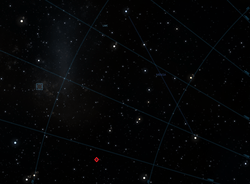HD 42936
HD 42936 is a binary star composed of an orange (K-type) main-sequence star and an L-type dwarf star just massive enough to burn hydrogen, located approximately 153 light-years away in the constellation of Mensa, taking its primary name from its Henry Draper Catalogue designation.
 Location of HD 42936 in the night sky. The star is marked within the red diamond. | |
| Observation data Epoch J2000.0 Equinox J2000.0 (ICRS) | |
|---|---|
| Constellation | Mensa |
| Right ascension | 06h 06m 29.8496258601s[1] |
| Declination | −72° 30′ 45.554148585″[1] |
| Apparent magnitude (V) | 9.09[1] |
| Characteristics | |
| HD 42936A | |
| Evolutionary stage | main sequence star |
| Spectral type | K0IV/V[1] |
| B−V color index | 0.91[1] |
| HD 42936B | |
| Evolutionary stage | main sequence star |
| Spectral type | L[2] |
| Astrometry | |
| Radial velocity (Rv) | +34.08 ± 0.77[1] km/s |
| Proper motion (μ) | RA: -1.412 [1] mas/yr Dec.: -383.637 [1] mas/yr |
| Parallax (π) | 21.2977 ± 0.1032[1] mas |
| Distance | 153.1 ± 0.7 ly (47.0 ± 0.2 pc) |
| Absolute magnitude (MV) | 5.73 |
| Details | |
| HD 42936A | |
| Mass | 0.87 M☉ |
| Radius | 0.91 R☉ |
| Luminosity (visual, LV) | 0.43 L☉ |
| Surface gravity (log g) | 4.3 cgs |
| Temperature | 5138 K |
| Metallicity [Fe/H] | 0.18 dex |
| Age | 10.9 Gyr |
| HD 42936B | |
| Mass | 79.9 MJup |
| Age | 10.9 Gyr |
| Other designations | |
| Database references | |
| SIMBAD | data |
| Exoplanet Archive | data |
| Extrasolar Planets Encyclopaedia | data |
History and nomenclature
The designation HD 42936 is from the Henry Draper Catalogue, which is based on spectral classifications made between 1911 and 1915 by Annie Jump Cannon and her co-workers, and was published between 1918 and 1924.
Characteristics
As a primary component of HD 42936 is K-type star, HD 42936 emits orange-tinted light.
Planetary system
In 2019, an analysis carried out by a team of astronomers led by astronomer John R. Barnes of the Dispersed Matter Planet Project (DMPP) confirmed the existence of a super-Earth[3] in orbit around HD 42936 A (DMPP-3).
| Companion (in order from star) |
Mass | Semimajor axis (AU) |
Orbital period (days) |
Eccentricity | Inclination | Radius |
|---|---|---|---|---|---|---|
| Ab | ≥ 2.58 +0.35 −0.58 M⊕ |
0.0662 +0.02 −0.02 |
6.6732 +0.0011 −0.0003 |
0.14 | — | — |
See also
- List of extrasolar planets
References
- HD 42936, entry, SIMBAD. Accessed online December 24, 2019.
- Haswell, Carole A.; Staab, Daniel; Barnes, John R.; Anglada-Escudé, Guillem; Fossati, Luca; Jenkins, James S.; Norton, Andrew J.; Doherty, James P. J.; Cooper, Joseph (2019). "Dispersed Matter Planet Project discoveries of ablating planets orbiting nearby bright stars". Nature Astronomy. arXiv:1912.10874. doi:10.1038/s41550-019-0973-y.
- Barnes, John R.; Haswell, Carole A.; Staab, Daniel; Anglada-Escudé, Guillem; Fossati, Luca; Doherty, James P. J.; Cooper, Joseph; Jenkins, James S.; Díaz, Matías R.; Soto, Maritza G.; Peña Rojas, Pablo A. (2019). "An ablating 2.6 M⊕ planet in an eccentric binary from the Dispersed Matter Planet Project". Nature Astronomy. arXiv:1912.10793. doi:10.1038/s41550-019-0972-z.